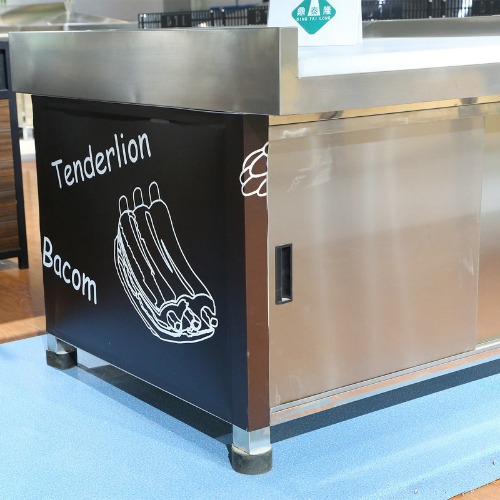Frozen food cabinets, also known as freezer display cases or freezer cabinets, are refrigeration units specifically designed to store and display frozen food products. The working principle of frozen food cabinets involves several key components and processes:
Compressor: The freezer cabinet contains a compressor, which is the heart of the refrigeration system. The compressor circulates refrigerant, usually a type of gas, throughout the cabinet.
Evaporator: Inside the freezer cabinet, there is an evaporator coil. This coil helps to remove heat from the cabinet by absorbing heat from the air.
Expansion valve: The expansion valve is responsible for regulating the flow of refrigerant into the evaporator coil. It controls the pressure and temperature of the refrigerant.
Refrigerant: The refrigerant is a specialized fluid that undergoes phase changes to absorb heat from the freezer cabinet. It evaporates in the evaporator coil, absorbing heat from the air, and then flows back to the compressor in its gaseous state.
Fans: The freezer cabinet typically includes fans that help circulate the air inside the cabinet. These fans distribute the cooled air evenly, ensuring that the temperature remains consistent throughout the storage area.
Insulation: The freezer cabinet is well-insulated to minimize heat transfer from the surrounding environment. Insulation materials, such as foam, are used to create a barrier that reduces the transfer of heat into the cabinet.
Thermostat: A thermostat is used to monitor and control the temperature inside the freezer cabinet. It senses the temperature and signals the compressor to start or stop running as needed to maintain the desired temperature range.
The working principle of a frozen food cabinet involves the circulation of refrigerant, which absorbs heat from the cabinet's interior and transfers it outside. The compressor pressurizes the refrigerant, causing it to release heat and liquefy. The liquid refrigerant then passes through the expansion valve, where it undergoes a pressure drop and evaporates in the evaporator coil. This evaporation process absorbs heat from the air, cooling the interior of the freezer cabinet. The cycle repeats as the refrigerant is compressed again by the compressor.
By maintaining a consistent low temperature, typically around -18°C (-0.4°F) or lower, frozen food cabinets ensure that frozen food products remain properly preserved and frozen until they are ready for purchase.Meanwhile,Frozen food cabinets offer several benefits for both businesses and consumers. Here are some key advantages of using frozen food cabinets:
Extended shelf life: Frozen food cabinets provide a controlled environment with low temperatures, which helps to preserve the quality and extend the shelf life of frozen food products. By keeping the products at temperatures below freezing, the growth of bacteria, mold, and other microorganisms is significantly slowed down, allowing the food to remain fresh for longer periods.
Food safety: Frozen food cabinets help ensure food safety by maintaining the required temperatures for frozen storage. This helps to prevent the growth of pathogens and minimizes the risk of foodborne illnesses. By storing frozen food products in cabinets specifically designed for freezing, businesses can adhere to food safety regulations and maintain high standards of product integrity.
Convenient storage and organization: Frozen food cabinets provide a convenient and organized storage solution for frozen food products. With adjustable shelves and compartments, businesses can effectively utilize the available space to store and display a variety of frozen items. This makes it easier for customers and staff to locate specific products and keeps the storage area tidy and efficient.
Display and visibility: Many frozen food cabinets are designed with transparent doors or glass panels, allowing customers to see the products without opening the cabinet. This enhances visibility and promotes sales by enticing customers with attractive product displays. Clear visibility also helps businesses keep track of inventory and easily restock the cabinet when necessary.
Energy efficiency: Modern frozen food cabinets are designed to be energy-efficient. They are equipped with features such as improved insulation, energy-saving lighting, and temperature control systems that help reduce energy consumption. This not only lowers operating costs for businesses but also contributes to environmental sustainability by reducing the carbon footprint associated with refrigeration.
Versatility and customization: Frozen food cabinets come in various sizes, configurations, and styles to suit different business needs. They can be standalone units or integrated into existing display systems. Additionally, some cabinets offer adjustable temperature settings, allowing businesses to cater to specific frozen food requirements, such as ice cream, meats, or vegetables.



 English
English русский
русский Deutsch
Deutsch Español
Español 中文
中文










